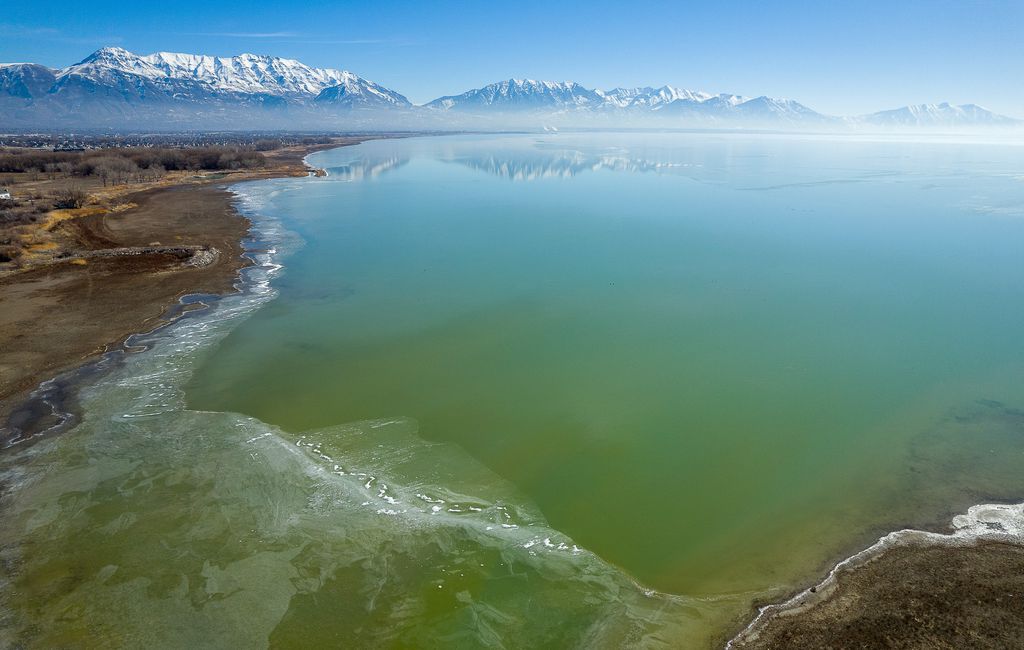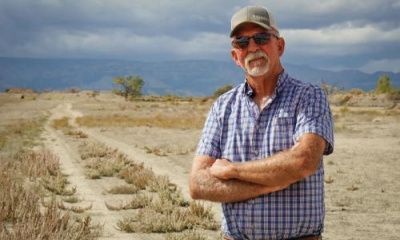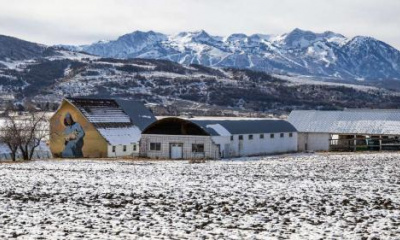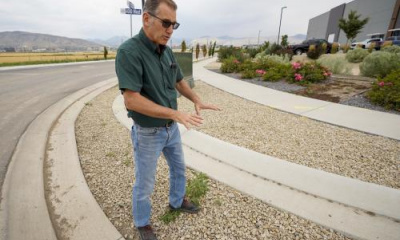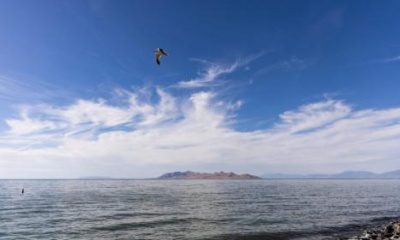For the last 25 years that Scott Martin has been practicing water law in Utah, the concept of appointing water judges or creating a water court has been a topic of conversation many times.
“And it’s always kind of just bubbled up and then it goes away,” Martin said, “now and then once in a while.”
But as the finite resource becomes more scarce, the conversation of appointing water judges in Utah has turned into a reality. A new rule passed by the Utah Judicial Council that goes into effect on Nov. 1 will establish at least three district court water judges throughout the state. The district court judges will volunteer to be a water judge and then be approved by the Judicial Council.
Kate Appleby, a senior judge with the Utah Court of Appeals who assisted in creating the new rule, says the judiciary recognized the growing need for specialized judges due to the complex nature and importance of Utah water law, especially as the state’s growth continues to outpace its water supply.
Currently, any district court judge in Utah can be assigned to a water law case, even if it’s not the judge’s specialty. The problem with this, Martin says, is that it’s led to “inconsistent decisions and inconsistent approaches” on Utah water cases. And Appleby acknowledges not every district judge is equipped to deal with water disputes.
“If you get one of these giant ones [water law cases] and it’s assigned to you, you’re suddenly scrambling to try to figure out what you need to know to be able to decide the case,” Appleby said. “And my thought is that there’s just got to be a better way to do it.”
The creation of specific water judges eliminates some of the inconsistencies and establishes a more “modernized approach” to water rulings, according to Martin.
Instead of water litigation landing in front of any district court judge, the new rule allows parties involved to request their case be heard by a water judge. The case will then be assigned to a judge at random. The rule also provides prospective water judges educational opportunities to learn the ins and outs of Utah water law in order to provide the most comprehensive verdict possible.
“We don’t set water law policy, but we make decisions that have far-reaching consequences,” Appleby said. “I mean, it’s deciding the rights to use one of our most precious public resources.”
The job of a water judge
Utah lawmakers made what many water experts consider monumental changes to the state’s water law during the 2022 Legislative session. However, the majority of water policies haven’t been updated since they were created decades, and in some cases, centuries ago.
“We are in a day where our landscape now looks very, very different than what it did one generation ago or five generations ago,” Martin said, “or when Brigham Young first came in the Salt Lake Valley and created the very first water right.”
Water disputes are projected to increase as water runs dry. And some water litigation sparked in the 1930s has yet to be resolved. That’s where a water judge is slated to slide in.
“There are more water rights than there is water,” Martin said.
The judges, Appleby says, should have a well-rounded understanding of both Utah water policy and hydrology science.
“Much of water policy that was decided over a hundred years ago is really affecting us now,” Appleby said, “before hydrology was as well understood as it is now.”
Appleby predicts district court judges that already have water cases on their docket will volunteer to fill the water judge role.
The rule also states there must be a supervising water judge that is responsible for helping train the appointed judges on Utah water policy. The Judicial Council is in the process of assembling the necessary resources in order to complete that educational step.
The water judges won’t hear all of Utah’s water disputes. The Judicial Council rule says judges will only handle chapters three and four of Title 73, which is Utah’s water code: the adjudication of water rights and the change application process for water use.
Most litigation comes out of chapters three and four, Martin says. And things can become sticky for water owners, like farmers, during the Water Rights General Adjudication, or general adjudication.
“The job of the general adjudication, basically, is to weed out all the dead water rights and give greater, clear and security to all the valid water rights,” Martin said. “It’s a very valuable, real property. So then there’s always a tussle over it.”
Water rights change application disagreements would also fall to the water judges. When someone files a change application, a slew of boxes must be checked before the state engineer gives the green light — and denying or approving an application change can spark a legal battle.
Martin doesn’t quite understand why the Judicial Council wouldn’t include the entirety of Utah’s water code when all of it is “very interconnected.”
“Chapter one includes things like ditch maintenance, pipeline usage, so on and so forth. Chapter two speaks to the authority and jurisdiction of the Utah state engineer,” Martin said. “It doesn’t make sense, at least in my mind, to have judges handling basically half of the landscape when it would be very, very easy just to expand it to all of Title 73.”
Martin’s perspective was echoed by other Utahns during the public comment period on the proposed rule, including the Utah Water Task Force, which analyzes and provides feedback on statewide water policy. Appleby is aware of the critique and says the judiciary is open to expanding the rule to cover the whole title once they get a better feel for demand.
Nonetheless, Blake Bingham, a deputy state engineer, believes establishing water judges in Utah is a move in the right direction to settling water disputes in a more “targeted fashion.”
“Having water judges who are knowledgeable and conversant in those intricate legal concepts will be valuable to the public at large,” he said, “and, more specifically, to the water users who are directly dependent on the equitable application of water law.”
Concerns over Utah water judges
Another critique presented by commenters, including Martin, was they would like to see more than three judges tackling water cases.
“You don’t want to just have the same judge over, over and over,” Martin said, “because what happens is you have the same judges handling the same clients, same interests and seeing the same lawyers.”
Appleby says the door is wide-open to add additional judges. She hopes there’s interest among district judges to take on water law cases, but she can’t force them to do so.
The last big apprehension commenters had was the potential freedom for water judges to set legal precedents on water cases.
“Elevating a trial court decision to the level of Appellate Court precedents, I don’t think is the best idea at this point,” Martin noted, “because every one of these cases is different.”
Appleby says if a water case travels beyond the district court level, “there is the potential that [setting precedent] could happen.” Water judges will have the ability to post “first impression” decisions, which is “an area of the law that has never been decided before,” according to Appleby.
A model in Colorado
Overall, Utah’s water community, like lawyers, water engineers and the Utah Water Task Force, considers the new rule a win. But some of the public comments made would like to see the judges expanded into a water court, like the one in Colorado.
Colorado is one of the only states that has a full-fledged water court system where most water disputes are automatically handled. But before the case reaches a judge, it’s handed off to the division water referee.
“I kind of do a sort of mediation to try to get all the parties together to resolve their issues if there is opposition in a case,” said John Cowan, one of seven water referees in Colorado.
Cowan has 18 months to settle water lawsuits to avoid trial. More than 90% of the time, Cowan says the water case in question never makes it to trial because the referee process is successful. But if the respective parties fail to agree on a solution, the case goes on the judge’s docket and gets set for trial.
Thanks to the water referee, most water judges in Colorado rule on three to four cases a year. And they’re usually “big cases” involving water holders disputing municipal water use.
“Say they [the municipality] want to buy half the water from the farmers on an irrigation canal,” Cowan said as an example. “Well, the people who oppose that case sort of come out of the woodwork. … And the opposers in the case are typically the other water users on that canal.”
The other water users are fighting back “because once that water is gone, it’s not in the canal anymore,” Cowan said. “So there’s no sharing. There’s no overflow.”
This problem is prevalent in Utah as well. As Utah’s need for housing continues to rise and new developments pop up around the state, similar cases are already in the midst of litigation.
Cowan also pointed out that having multiple entities adjudicating water rights can lead to confusion when it comes to who has priority over the water right in question.
But when “one court handles all the water in that tributary to that river system and that one water division,” Cowan said, “you avoid that problem.”
And while the state engineer is the one to approve a water right in Utah, public commenters highlighted having a minimum of three judges addressing the bulk of water controversy throughout the entire state could pose a similar challenge.
Appleby, the Utah Appeals judge, says the power to establish water courts lies in the hands of Utah lawmakers, not the judiciary.
“The Courts can’t just say, ‘We’re going to create a whole new court.’ It has to go through the Legislature,” Appleby said. “That’s not something that happens overnight. It’s probably a multiyear process involving discussions with stakeholders.”

